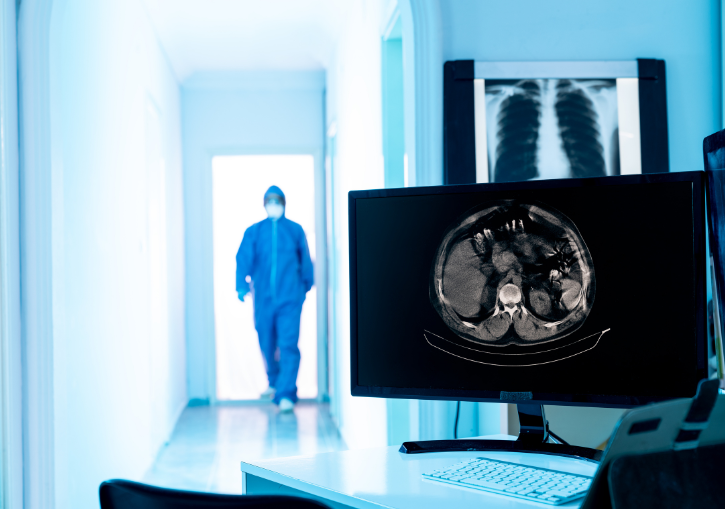
Types of Imaging Modalities
Medical imaging is useful in providing accurate diagnostics to patients as well as creating optimal treatment plans [1]. Different diseases often require other technologies to be imaged so doctors can get a better look at specific organs. The first radiology modality is X-rays. X-rays are known to work using radiation detected using a film or digital detector [1]. X-rays are often used for fractures, lung infections, and even dental work [1]. The second modality is fluoroscopy, which uses X-rays to image organs in real-time motion [1]. This imaging helps doctors during joint injections and catheterization procedures. The third modality is computed tomography, which non-invasively uses X-rays to create cross-sectional images of the body [1]. This can be useful in detecting injuries not normally captured during X-rays. Furthermore, CT scans are also effective at detecting tumors and their stages [1].

The fourth modality is magnetic resonance imaging (MRI). MRI is non-invasive and is often safer for patients since it doesn’t use ionizing radiation [1]. MRI is also a useful tool for detecting internal organs, especially injuries to the soft tissue [1]. However, MRI does have limitations, mostly due to the fact that examination can take up to an hour and patients must remain still during it [1]. Furthermore, MRI may cause issues with medical devices worn or implanted in the patient [1]. The fifth modality is ultrasounds, which use high-frequency sound waves to create images of organs and tissues [1]. These images often show real-time monitoring of tissues, especially their growth [1]. Furthermore, ultrasounds are safe for pregnant women since they don’t use ionizing radiation [1]. Overall, it’s important to be aware that radiology consists of multiple modalities that help target different goals and diseases depending on the patient.
Future of Medical Imaging Using AI
Medical imaging has been around since 1895 when X-rays were first created [2]. Therefore, it’s no surprise that we have multiple imaging modalities that specialize in collecting images ranging in depth and structure of various organs and systems. A new technology in medical imaging is implementing cloud technologies and AI to help doctors reduce burnout while also improving screenings [3]. This technology analyzes medical images faster and more accurately, which optimizes the workflow [3]. Furthermore, once AI detects an anomaly, it looks through old examinations to see if there is a similar case that can help radiologists and doctors better diagnose and treat the current case [3]. Overall, integrating AI and cloud technologies allows imaging to be accessed across different electronic health systems and mutual archives [3]. Furthermore, this data can be used with genetics and patient data so that accurate diagnostics are made.

Removing Bias in Imaging
Even with all the modalities in medical imaging, it’s important to bring awareness to bias in imaging that can lead to misdiagnoses in minorities. For instance, some doctors in the US are not trained to effectively or accurately recognize skin symptoms in people of color or indigenous people [4]. For instance, diseases may show up differently in people with darker skin compared to those with lighter skin. This can lead to doctors thinking you have something else and can make the disease worse over time since it is misdiagnosed [4]. Unfortunately, this can result in people of color having to wait months, even years before they receive a proper and accurate diagnosis regarding skin conditions.

Overall, doctors need to receive better and more adequate training so they know how skin conditions look on various skin tones. AI is also useful in recognizing skin-related issues in people with different skin colors and can reduce bias while also improving prompt diagnoses in patients [4]. However, AI must be trained effectively so it can recognize skin conditions regardless of the skin tone. This will require collaboration and awareness in the medical imaging community so that minorities are no longer misdiagnosed.
HITS
HITS collaborates with clinicians in the development of health informatics for all populations. We provide patient-centric tools that promote safe, timely, and equitable care. We tailor software and project management support products to meet our customer’s needs by incorporating human-centered solutions at every step. HITS also focuses on transforming health care by analyzing integrated medical solutions and evaluating information systems. Our goal is to enhance individual and population health outcomes, improve patient care, and strengthen the clinician-patient relationship. Finally, HITS encourages and promotes secure and safe access to relevant electronic health information data.
References
- https://www.ccdcare.com/resource-center/radiology-modalities
- https://pressbooks.bccampus.ca/advancedanatomy1sted/chapter/medical-imaging/#:~:text=X%2Drays%20are%20the%20oldest,and%2C%20infections%20to%20various%20tissues.
- https://healthtechmagazine.net/article/2023/05/whats-next-medical-imaging-cloud-and-ai-technologies
- https://www.everydayhealth.com/black-health/too-many-doctors-are-misdiagnosing-disease-on-skin-of-color/